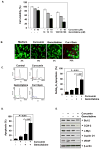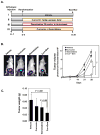Curcumin potentiates the antitumor effects of gemcitabine in an orthotopic model of human bladder cancer through suppression of proliferative and angiogenic biomarkers
- PMID: 19682434
- PMCID: PMC3181149
- DOI: 10.1016/j.bcp.2009.08.007
Curcumin potentiates the antitumor effects of gemcitabine in an orthotopic model of human bladder cancer through suppression of proliferative and angiogenic biomarkers
Retraction in
-
Retraction notice to “Curcumin potentiates the antitumor effects of gemcitabine in an orthotopic model of human bladder cancer through suppression of proliferative and angiogenic biomarkers” [Biochem. Pharmacol. 79 (2010) 218–228].Biochem Pharmacol. 2016 Feb 15;102:145. doi: 10.1016/j.bcp.2015.11.010. Epub 2016 Feb 20. Biochem Pharmacol. 2016. PMID: 26985467 Free PMC article. No abstract available.
Abstract
Little progress has been made in the last three decades in the treatment of bladder cancer. Novel agents that are nontoxic and can improve the current standard of care of this disease are urgently needed. Curcumin, a component of Curcuma longa (also called turmeric), is one such agent that has been shown to suppress pathways linked to oncogenesis, including cell survival, proliferation, invasion and angiogenesis. We investigated whether curcumin has potential to improve the current therapy for bladder cancer, using an orthotopic mouse model. Curcumin potentiated the apoptotic effects of gemcitabine against human bladder cancer 253JBV cells in culture. Electrophoretic mobility shift assay revealed that curcumin also suppressed the gemcitabine-induced activation of the cell survival transcription factor NF-kappaB. In an orthotopic mouse model, bioluminescence imaging revealed that while curcumin alone significantly reduced the bladder tumor volume, maximum reduction was observed when curcumin was used in combination with gemcitabine (P<0.01 versus vehicle; P<0.01 versus gemcitabine alone). Curcumin also significantly decreased the proliferation marker Ki-67 and microvessel density (CD31) (P<0.01 versus vehicle; P<0.01 versus gemcitabine alone), but maximum reduction occurred when it was combined with gemcitabine (P<0.01 versus vehicle; P<0.01 versus gemcitabine alone). Curcumin abolished the constitutive activation of NF-kappaB in the tumor tissue; induced apoptosis, and decreased cyclin D1, VEGF, COX-2, c-myc and Bcl-2 expression in the bladder cancer tissue. Overall our results suggest that curcumin alone exhibits significant antitumor effects against human bladder cancer and it further potentiates the effects of gemictabine, possibly through the modulation of NF-kappaB signaling pathway.
Figures






References
-
- Jemal A, Siegel R, Ward E, Hao Y, Xu J, Murray T, et al. Cancer statistics, 2008. CA: a cancer journal for clinicians. 2008;58:71–96. - PubMed
-
- von der Maase H, Sengelov L, Roberts JT, Ricci S, Dogliotti L, Oliver T, et al. Long-term survival results of a randomized trial comparing gemcitabine plus cisplatin, with methotrexate, vinblastine, doxorubicin, plus cisplatin in patients with bladder cancer. J Clin Oncol. 2005;23:4602–8. - PubMed
-
- El Karak F, Flechon A. Gemcitabine in bladder cancer. Expert opinion on pharmacotherapy. 2007;8:3251–6. - PubMed
-
- Kunnumakkara AB, Anand P, Aggarwal BB. Curcumin inhibits proliferation, invasion, angiogenesis and metastasis of different cancers through interaction with multiple cell signaling proteins. Cancer letters. 2008;269:199–225. - PubMed
-
- Kamat AM, Sethi G, Aggarwal BB. Curcumin potentiates the apoptotic effects of chemotherapeutic agents and cytokines through down-regulation of nuclear factor-kappaB and nuclear factor-kappaB-regulated gene products in IFN-alpha-sensitive and IFN-alpha-resistant human bladder cancer cells. Molecular cancer therapeutics. 2007;6:1022–30. - PubMed
Publication types
MeSH terms
Substances
Grants and funding
LinkOut - more resources
Full Text Sources
Medical
Research Materials

